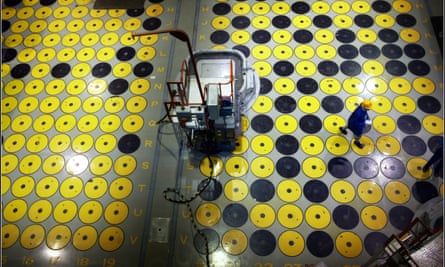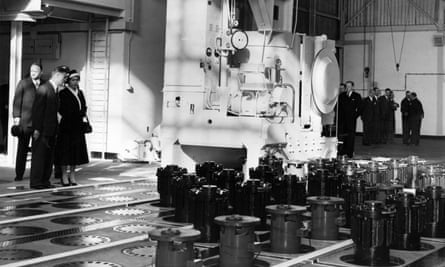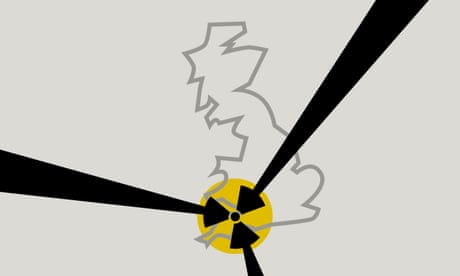I
f you take the cosmic view of Sellafield, the superannuated nuclear facility in north-west England, its story began long before the Earth took shape. About 9bn years ago, tens of thousands of giant stars ran out of fuel, collapsed upon themselves, and then exploded. The sheer force of these supernova detonations mashed together the matter in the stars’ cores, turning lighter elements like iron into heavier ones like uranium. Flung out by such explosions, trillions of tonnes of uranium traversed the cold universe and wound up near our slowly materialising solar system.
And here, over roughly 20m years, the uranium and other bits of space dust and debris cohered to form our planet in such a way that the violent tectonics of the young Earth pushed the uranium not towards its hot core but up into the folds of its crust. Within reach, so to speak, of the humans who eventually came along circa 300,000BC, and who mined the uranium beginning in the 1500s, learned about its radioactivity in 1896 and started feeding it into their nuclear reactors 70-odd years ago, making electricity that could be relayed to their houses to run toasters and light up Christmas trees.
Sellafield compels this kind of gaze into the abyss of deep time because it is a place where multiple time spans – some fleeting, some cosmic – drift in and out of view. Laid out over six square kilometres, Sellafield is like a small town, with nearly a thousand buildings, its own roads and even a rail siding – all owned by the government, and requiring security clearance to visit. Sellafield’s presence, at the end of a road on the Cumbrian coast, is almost hallucinatory. One moment you’re passing cows drowsing in pastures, with the sea winking just beyond. Then, having driven through a high-security gate, you’re surrounded by towering chimneys, pipework, chugging cooling plants, everything dressed in steampunk. The sun bounces off metal everywhere. In some spots, the air shakes with the noise of machinery. It feels like the most manmade place in the world.
Since it began operating in 1950, Sellafield has had different duties. First it manufactured plutonium for nuclear weapons. Then it generated electricity for the National Grid, until 2003. It also carried out years of fuel reprocessing: extracting uranium and plutonium from nuclear fuel rods after they’d ended their life cycles. The very day before I visited Sellafield, in mid-July, the reprocessing came to an end as well. It was a historic occasion. From an operational nuclear facility, Sellafield turned into a full-time storage depot – but an uncanny, precarious one, filled with toxic nuclear waste that has to be kept contained at any cost.
Nothing is produced at Sellafield any more. Which was just as well, because I’d gone to Sellafield not to observe how it lived but to understand how it is preparing for its end. Sellafield’s waste – spent fuel rods, scraps of metal, radioactive liquids, a miscellany of other debris – is parked in concrete silos, artificial ponds and sealed buildings. Some of these structures are growing, in the industry’s parlance, “intolerable”, atrophied by the sea air, radiation and time itself. If they degrade too much, waste will seep out of them, poisoning the Cumbrian soil and water.
To prevent that disaster, the waste must be hauled out, the silos destroyed and the ponds filled in with soil and paved over. The salvaged waste will then be transferred to more secure buildings that will be erected on site. But even that will be only a provisional arrangement, lasting a few decades. Nuclear waste has no respect for human timespans. The best way to neutralise its threat is to move it into a subterranean vault, of the kind the UK plans to build later this century. Once interred, the waste will be left alone for tens of thousands of years, while its radioactivity cools. Dealing with all the radioactive waste left on site is a slow-motion race against time, which will last so long that even the grandchildren of those working on site will not see its end. The process will cost at least £121bn.
Compared to the longevity of nuclear waste, Sellafield has only been around for roughly the span of a single lunch break within a human life. Still, it has lasted almost the entirety of the atomic age, witnessing both its earliest follies and its continuing confusions. In 1954, Lewis Strauss, the chair of the US Atomic Energy Commission, predicted that nuclear energy would make electricity “too cheap to meter”. That forecast has aged poorly. The main reason power companies and governments aren’t keener on nuclear power is not that activists are holding them back or that uranium is difficult to find, but that producing it safely is just proving too expensive.
Strauss was, like many others, held captive by one measure of time and unable to truly fathom another. The short-termism of policymaking neglected any plans that had to be made for the abominably lengthy, costly life of radioactive waste. I kept being told, at Sellafield, that science is still trying to rectify the decisions made in undue haste three-quarters of a century ago. Many of the earliest structures here, said Dan Bowman, the head of operations at one of Sellafield’s two waste storage ponds, “weren’t even built with decommissioning in mind”.
As a result, Bowman admitted, Sellafield’s scientists are having to invent, mid-marathon, the process of winding the site down – and they’re finding that they still don’t know enough about it. They don’t know exactly what they’ll find in the silos and ponds. They don’t know how much time they’ll need to mop up all the waste, or how long they’ll have to store it, or what Sellafield will look like afterwards. The decommissioning programme is laden “with assumptions and best guesses”, Bowman told me. It will be finished a century or so from now. Until then, Bowman and others will bend their ingenuity to a seemingly self-contradictory exercise: dismantling Sellafield while keeping it from falling apart along the way.
T
o take apart an ageing nuclear facility, you have to put a lot of other things together first. New technologies, for instance, and new buildings to replace the intolerable ones, and new reserves of money. (That £121bn price tag may swell further.) All of Sellafield is in a holding pattern, trying to keep waste safe until it can be consigned to the ultimate strongroom: the geological disposal facility (GDF), bored hundreds of metres into the Earth’s rock, a project that could cost another £53bn. Even if a GDF receives its first deposit in the 2040s, the waste has to be delivered and put away with such exacting caution that it can be filled and closed only by the middle of the 22nd century.
Anywhere else, this state of temporariness might induce a mood of lax detachment, like a transit lounge to a frequent flyer. But at Sellafield, with all its caches of radioactivity, the thought of catastrophe is so ever-present that you feel your surroundings with a heightened keenness. At one point, when we were walking through the site, a member of the Sellafield team pointed out three different waste storage facilities within a 500-metre radius. The spot where we stood on the road, he said, “is probably the most hazardous place in Europe”.
Flasks of nuclear waste in the vitrified product store at Sellafield in 2003. Yellow circles denote full flasks, black are empty. Photograph: Christopher Thomond/The Guardian
Sellafield’s waste comes in different forms and potencies. Spent fuel rods and radioactive pieces of metal rest in skips, which in turn are submerged in open, rectangular ponds, where water cools them and absorbs their radiation. The skips have held radioactive material for so long that they themselves count as waste. The pond beds are layered with nuclear sludge: degraded metal wisps, radioactive dust and debris. Discarded cladding, peeled off fuel rods like banana-skins, fills a cluster of 16-metre-deep concrete silos partially sunk into the earth. More dangerous still are the 20 tonnes of melted fuel inside a reactor that caught fire in 1957 and has been sealed off and left alone ever since. Somewhere on the premises, Sellafield has also stored the 140 tonnes of plutonium it has purified over the decades. It’s the largest such hoard of plutonium in the world, but it, too, is a kind of waste, simply because nobody wants it for weapons any more, or knows what else to do with it.
It has been a dithery decade for nuclear policy. After the 2011 disaster at the Fukushima nuclear plant in Japan, several countries began shuttering their reactors and tearing up plans for new ones. They’d become inordinately expensive to build and maintain, in any case, especially compared to solar and wind installations. In the UK, the fraction of electricity generated by nuclear plants has slid steadily downwards, from 25% in the 1990s to 16% in 2020. Of the five nuclear stations still producing power, only one will run beyond 2028. Hinkley Point C, the first new nuclear plant in a generation, is being built in Somerset, but its cost has bloated to more than £25bn.
This year, though, governments felt the pressure to redo their sums when sanctions on Russia abruptly choked off supplies of oil and gas. Wealthy nations suddenly found themselves worrying about winter blackouts. In this crisis, governments are returning to the habit they were trying to break. Germany had planned to abandon nuclear fuel by the end of this year, but in October, it extended that deadline to next spring. The US allocated $6bn to save struggling plants; the UK pressed ahead with plans for Sizewell C, a nuclear power station to be built in Suffolk. Japan, its Fukushima trauma just a decade old, announced that it will commission new plants. Even as Sellafield is cleaning up after the first round of nuclear enthusiasm, another is getting under way.
A
ny time spent in Sellafield is scored to a soundtrack of alarms and signals. The radiation trackers clipped to our protective overalls let off soft cheeps, their frequency varying as radioactivity levels changed around us. Before leaving every building, we ran Geiger counters over ourselves – always remembering to scan the tops of our heads and the soles of our feet – and these clacked like rattlesnakes. At one spot, our trackers went mad. A pipe on the outside of a building had cracked, and staff had planted 10ft-tall sheets of lead into the ground around it to shield people from the radiation. It was perfectly safe, my guide assured me. We power-walked past nonetheless.
The day I visited Sellafield was the UK’s hottest ever. We sweltered even before we put on heavy boots and overalls to visit the reprocessing plant, where, until the previous day, technicians had culled uranium and plutonium out of spent fuel. Every second, on each of the plant’s four floors, I heard a beep – a regular pulse, reminding everyone that nothing is amiss. “We’ve got folks here who joined at 18 and have been here more than 40 years, working only in this building,” said Lisa Dixon, an operations manager. Dixon’s father had been a welder here, and her husband is one of the firefighters stationed permanently on site. She meets aunts and cousins on her shifts all the time. When she says Sellafield is one big family, she isn’t just being metaphorical.
I only ever saw a dummy of a spent fuel rod; the real thing would have been a metre long, weighed 10-12kg, and, when it emerged from a reactor, run to temperatures of 2,800C, half as hot as the surface of the sun. In a reactor, hundreds of rods of fresh uranium fuel slide into a pile of graphite blocks. Then a stream of neutrons, usually emitted by an even more radioactive metal such as californium, is directed into the pile. Those neutrons generate more neutrons out of uranium atoms, which generate still more neutrons out of other uranium atoms, and so on, the whole process begetting vast quantities of heat that can turn water into steam and drive turbines.
During this process, some of the uranium atoms, randomly but very usefully, absorb darting neutrons, yielding heavier atoms of plutonium: the stuff of nuclear weapons. The UK’s earliest reactors – a type called Magnox – were set up to harvest plutonium for bombs; the electricity was a happy byproduct. The government built 26 such reactors across the country. They’re all being decommissioned now, or awaiting demolition. It turned out that if you weren’t looking to make plutonium nukes to blow up cities, Magnox was a pretty inefficient way to light up homes and power factories.
Barrels containing high-level radioactive nuclear waste stored in a pool at Sellafield, in 2002. Photograph: Odd Andersen/AFP/Getty Images
For most of the latter half of the 20th century, one of Sellafield’s chief tasks was reprocessing. Once uranium and plutonium were extracted from used fuel rods, it was thought, they could be stored safely – and perhaps eventually resold, to make money on the side. Beginning in 1956, spent rods came to Cumbria from plants across the UK, but also by sea from customers in Italy and Japan. Sellafield has taken in nearly 60,000 tonnes of spent fuel, more than half of all such fuel reprocessed anywhere in the world. The rods arrived at Sellafield by train, stored in cuboid “flasks” with corrugated sides, each weighing about 50 tonnes and standing 1.5 metres tall. The flasks were cast from single ingots of stainless steel, their walls a third of a metre thick. Responding to worries about how robust these containers were, the government, in 1984, arranged to have a speeding train collide head-on with a flask. The video is spectacular. At 100mph, a part of the locomotive exploded and the train derailed. But the flask, a few scratches and dents aside, stayed intact.
At Sellafield, the rods were first cooled in ponds of water for between 90 and 250 days. Then they were skinned of their cladding and dissolved in boiling nitric acid. From that liquor, technicians separated out uranium and plutonium, powdery like cumin. This cycle, from acid to powder, lasted up to 36 hours, Dixon said – and it hadn’t improved a jot in efficiency in the years she’d been there. The only change was the dwindling number of rods coming in, as Magnox reactors closed everywhere.
The day before I met Dixon, technicians had fed one final batch of spent fuel into acid – and that was that, the end of reprocessing. It marked Sellafield’s transition from an operational facility to a depot devoted purely to storage and containment. The rods went in late in the evening, after hours of technical hitches, so the moment itself was anticlimactic. “They just dropped through, and you heard nothing. So it was like: ‘OK, that’s it? Let’s go home,’” Dixon said. But the following morning, when I met her, she felt sombre, she admitted. “Everybody’s thinking: ‘What do we do? There’s no fuel coming in.’ I don’t think it’s really hit the team just yet.”
The reprocessing plant’s end was always coming. The pipes and steam lines, many from the 1960s, kept fracturing. Dixon’s team was running out of spare parts that aren’t manufactured any more. “Since December 2019,” Dixon said, “I’ve only had 16 straight days of running the plant at any one time.” Best to close it down – to conduct repairs, clean the machines and take them apart. Then, at last, the reprocessing plant will be placed on “fire watch”, visited periodically to ensure nothing in the building is going up in flames, but otherwise left alone for decades for its radioactivity to dwindle, particle by particle.
L
ike malign glitter, radioactivity gets everywhere, turning much of what it touches into nuclear waste. The humblest items – a paper towel or a shoe cover used for just a second in a nuclear environment – can absorb radioactivity, but this stuff is graded as low-level waste; it can be encased in a block of cement and left outdoors. (Cement is an excellent shield against radiation. A popular phrase in the nuclear waste industry goes: “When in doubt, grout.”) Even the paper towel needs a couple of hundred years to shed its radioactivity and become safe, though. A moment of use, centuries of quarantine: radiation tends to twist time all out of proportion.
On the other hand, high-level waste – the byproduct of reprocessing – is so radioactive that its containers will give off heat for thousands of years. It, too, will become harmless over time, but the scale of that time is planetary, not human. The number of radioactive atoms in the kind of iodine found in nuclear waste byproducts halves every 16m years. In comparison, consider how different the world looked a mere 7,000 years ago, when a determined pedestrian could set out from the Humber estuary, in northern England, and walk across to the Netherlands and then to Norway. Planning for the disposal of high-level waste has to take into account the drift of continents and the next ice age.
All radioactivity is a search for stability. Most of the atoms in our daily lives – the carbon in the wood of a desk, the oxygen in the air, the silicon in window glass – have stable nuclei. But in the atoms of some elements like uranium or plutonium, protons and neutrons are crammed into their nuclei in ways that make them unsteady – make them radioactive. These atoms decay, throwing off particles and energy over years or millennia until they become lighter and more stable. Nuclear fuel is radioactive, of course, but so is nuclear waste, and the only thing that can render such waste harmless is time.
Waste can travel incognito, to fatal effect: radioactive atoms carried by the wind or water, entering living bodies, riddling them with cancer, ruining them inside out. During the 1957 reactor fire at Sellafield, a radioactive plume of particles poured from the top of a 400-foot chimney. A few days later, some of these particles were detected as far away as Germany and Norway. Near Sellafield, radioactive iodine found its way into the grass of the meadows where dairy cows grazed, so that samples of milk taken in the weeks after the fire showed 10 times the permissible level. The government had to buy up milk from farmers living in 500 sq km around Sellafield and dump it in the Irish Sea.
Queen Elizabeth II at the opening ceremony of the Windscale nuclear power station, later known as Sellafield, in 1956. Photograph: Hulton Archive
From the outset, authorities hedged and fibbed. For three days, no one living in the area was told about the gravity of the accident, or even advised to stay indoors and shut their windows. Workers at Sellafield, reporting their alarming radiation exposure to their managers, were persuaded that they’d “walk [it] off on the way home”, the Daily Mirror reported at the time. A government inquiry was then held, but its report was not released in full until 1988. For nearly 30 years, few people knew that the fire dispersed not just radioactive iodine but also polonium, far more deadly. The estimated toll of cancer cases has been revised upwards continuously, from 33 to 200 to 240. Sellafield took its present name only in 1981, in part to erase the old name, Windscale, and the associated memories of the fire.
The invisibility of radiation and the opacity of governments make for a bad combination. Sellafield hasn’t suffered an accident of equivalent scale since the 1957 fire, but the niggling fear that some radioactivity is leaking out of the facility in some fashion has never entirely vanished. In 1983, a Sellafield pipeline discharged half a tonne of radioactive solvent into the sea. British Nuclear Fuels Limited, the government firm then running Sellafield, was fined £10,000. Around the same time, a documentary crew found higher incidences than expected of leukaemia among children in some surrounding areas. A government study concluded that radiation from Sellafield wasn’t to blame. Perhaps, the study suggested, the leukaemia had an undetected, infectious cause.
It was no secret that Sellafield kept on site huge stashes of spent fuel rods, waiting to be reprocessed. This was lucrative work. An older reprocessing plant on site earned £9bn over its lifetime, half of it from customers overseas. But the pursuit of commercial reprocessing turned Sellafield and a similar French site into “de facto waste dumps”, the journalist Stephanie Cooke found in her book In Mortal Hands. Sellafield now requires £2bn a year to maintain. What looked like a smart line of business back in the 1950s has now turned out to be anything but. With every passing year, maintaining the world’s costliest rubbish dump becomes more and more commercially calamitous.
The expenditure rises because structures age, growing more rickety, more prone to mishap. In 2005, in an older reprocessing plant at Sellafield, 83,000 litres of radioactive acid – enough to fill a few hundred bathtubs – dripped out of a ruptured pipe. The plant had to be shut down for two years; the cleanup cost at least £300m. The year before the pandemic, a sump tank attached to a waste pond sprang a leak and had to be grouted shut. Around the same time, an old crack in a waste silo opened up again. It posed no health risk, Sellafield determined, so it was still dripping liquid into the ground when I visited. The silos are rudimentary concrete bins, built for waste to be tipped in, but for no other kind of access. Their further degradation is a sure thing. It all put me in mind of a man who’d made a house of ice in deepest winter but now senses spring around the corner, and must move his furniture out before it all melts and collapses around him.
S
ome industrial machines have soothing names; the laser snake is not one of them. After its fat, six-metre-long body slinks out of its cage-like housing, it can rear up in serpentine fashion, as if scanning its surroundings for prey. Its anatomy is made up of accordion folds, so it can stretch and compress on command. The snake’s face is the size and shape of a small dinner plate, with a mouth through which it fires a fierce, purple shaft of light. The laser can slice through inches-thick steel, sparks flaring from the spot where the beam blisters the metal. It took two years and £5m to develop this instrument. If Philip K Dick designed your nightmares, the laser snake would haunt them.
Six years ago, the snake’s creators put it to work in a demo at Sellafield. A 10-storey building called B204 had been Sellafield’s first reprocessing facility, but in 1973, a rogue chemical reaction filled the premises with radioactive gas. Thirty-four workers were contaminated, and the building was promptly closed down. Gas, fuel rods and radioactive equipment were all left in place, in sealed rooms known as cells, which turned so lethal that humans haven’t entered them since. The snake, though, could slither right in – through a hole drilled into a cell wall, and right up to a two-metre-high, double-walled steel vat once used to dissolve fuel in acid. Like so much else in B204, the vat was radioactive waste. It had to be disposed of, but it was too big to remove in one piece.
For six weeks, Sellafield’s engineers prepared for the task, rehearsing on a 3D model, ventilating the cell, setting up a stream of air to blow away the molten metal, ensuring that nothing caught fire from the laser’s sparks. Once in action, the snake took mere minutes to cut up the vat. But then the pieces were left in the cell. No one had figured out yet how to remove them. The snake hasn’t been deployed since 2015, because other, more urgent tasks lie at hand.
The Magnox reprocessing area at Sellafield in 1986. Photograph: Brian Harris/Alamy
As a project, tackling Sellafield’s nuclear waste is a curious mix of sophistication and what one employee called the “poky stick” approach. On the one hand, it calls for ingenious machines like the laser snake, conceived especially for Sellafield. But the years-long process of scooping waste out can also feel crude and time-consuming – “like emptying a wheelie bin with a teaspoon”, Phil Atherton, a manager working with the silo team, told me. New forms of storage have to be devised for the waste, once it’s removed. These have to be secure and robust – but they can’t be irretrievably secure and robust, because scientists may yet develop better ways to deal with waste. “You don’t want to do anything that forecloses any prospective solutions,” Atherton said. No possible version of the future can be discounted.
We walked on the roof of the silos, atop their heavy concrete caps. Below us, submerged in water, lay decades’ worth of intermediate-level waste – not quite as radioactive as spent fuel rods, but more harmful than low-level paper towels. Most of it was swarf – the cladding skinned off fuel rods, broken into chunks three or four inches long. What Atherton really wanted to show off, though, was a new waste retrieval system: a machine as big as a studio apartment, designed from scratch over two decades and built at a cost of £100m. Its 13,500 working parts together weigh 350 tonnes. It perched on rails running the length of the building, so that it could be moved and positioned above an uncapped silo.
An operator sits inside the machine, reaching long, mechanical arms into the silo to fish out waste. In the water’s gloom, cameras offer little help, he said: “You’re mostly playing by feel.” In the two preceding months, the team had pulled out enough waste to fill four skips. Eventually there will be two more retrieval machines in the silos, their arms poking and clasping like the megafauna cousins of those fairground soft-toy grabbers. Even so, it will take until 2050 to empty all the silos. The skips of extricated waste will be compacted to a third of their volume, grouted and moved into another Sellafield warehouse; at some point, they will be sequestered in the ground, in the GDF that is, at present, hypothetical.
Not far from the silos, I met John Cassidy, who has helped manage one of Sellafield’s waste storage ponds for more than three decades – so long that a colleague called him “the Oracle”. Cassidy’s pond, which holds 14,000 cubic metres of water, resembles an extra-giant, extra-filthy lido planted in the middle of an industrial park. In the water, the skips full of used fuel rods were sometimes stacked three deep, and when one was placed in or pulled out, rods tended to tumble out on to the floor of the pond.
We climbed a staircase in a building constructed over a small part of the pond. On one floor, we stopped to look at a remotely operated vehicle, or ROV – a steamer trunk-sized thing with a yellow carapace, floating in the algal-green water. “You see the little arm at the end of it?” Cassidy said. “So it’ll float down to the bottom of the pond, pick up a nuclear rod that has fallen out of a skip, and put it back into the skip.” Sometimes, though, a human touch is required. This winter, Sellafield will hire professional divers from the US. Nuclear plants keep so much water on hand – to cool fuel, moderate the reactor’s heat, or generate steam – that a class of specialist divers works only in the ponds and tanks at these plants, inspecting and repairing them. In Sellafield, these nuclear divers will put on radiation-proof wetsuits and tidy up the pond floor, reaching the places where robotic arms cannot go.
Two floors above, a young Sellafield employee sat in a gaming chair, working at a laptop with a joystick. He was manoeuvring an ROV fitted with a toilet brush – “a regular brush, bought at the store,” he said, “just kind of reinforced with a bit of plastic tube”. With a delicacy not ordinarily required of it, the toilet brush wiped debris and algae off a skip until the digits “9738”, painted in black, appeared on the skip’s flank. When they arrived over the years, during the heyday of reprocessing, the skips were unloaded into pools so haphazardly that Sellafield is now having to build an underwater map of what is where, just to know best how to get it all out. Skip No 9738 went into the map, one more hard-won addition to Sellafield’s knowledge of itself.
“W
aste disposal is a completely solved problem,” Edward Teller, the father of the hydrogen bomb, declared in 1979. He was right, but only in theory. The nuclear industry certainly knew about the utility of water, steel and concrete as shields against radioactivity, and by the 1970s, the US government had begun considering burying reactor waste in a GDF. But Teller was glossing over the details, namely: the expense of keeping waste safe, the duration over which it has to be maintained, the accidents that could befall it, the fallout of those accidents. Four decades on, not a single GDF has begun to operate anywhere in the world. Teller’s complete solution is still a hypothesis.
Instead, there have been only interim solutions, although to a layperson, even these seem to have been conceived in some scientist’s intricate delirium. High-level waste, like the syrupy liquor formed during reprocessing, has to be cooled first, in giant tanks. Then it is vitrified: mixed with three parts glass beads and a little sugar, until it turns into a hot block of dirty-brown glass. (The sugar reduces the waste’s volatility. “We like to get ours from Tate & Lyle,” Eva Watson-Graham, a Sellafield information officer, said.) Since 1991, stainless steel containers full of vitrified waste, each as tall as a human, have been stacked 10-high in a warehouse. If you stand on the floor above them, Watson-Graham said, you can still sense a murmuring warmth on the soles of your shoes.
Even this elaborate vitrification is insufficient in the long, long, long run. Fire or flood could destroy Sellafield’s infrastructure. Terrorists could try to get at the nuclear material. Governments change, companies fold, money runs out. Nations dissolve. Glass degrades. The ground sinks and rises, so that land becomes sea and sea becomes land. The contingency planning that scientists do today – the kind that wasn’t done when the industry was in its infancy – contends with yawning stretches of time. Hence the GDF: a terrestrial cavity to hold waste until its dangers have dried up and it becomes as benign as the surrounding rock.
A glimpse of such an endeavour is available already, beneath Finland. From Helsinki, if you drive 250km west, then head another half-km down, you will come to a warren of tunnels called Onkalo. Other underground vaults have been built to store intermediate waste, but for briefer periods; one that opened in a salt cavern in New Mexico in 1999 will last merely 10,000 years. If Onkalo begins operating on schedule, in 2025, it will be the world’s first GDF for spent fuel and high-level reactor waste – 6,500 tonnes of the stuff, all from Finnish nuclear stations. It will cost €5.5bn and is designed to be safe for a million years. The species that is building it, Homo sapiens, has only been around for a third of that time.
Constructed by a firm named Posiva, Onkalo has been hewn into the island of Olkiluoto, a brief bridge’s length off Finland’s south-west coast. When I visited in October, the birches on Olkiluoto had turned to a hot blush. The air was pure Baltic brine. In a van, we went down a steep, dark ramp for a quarter of an hour until we reached Onkalo’s lowest level, and here I caught the acrid odour of a closed space in which heavy machinery has run for a long time. Up close, the walls were pimpled and jagged, like stucco, but at a distance, the rock’s surface undulated like soft butter. Twice, we followed a feebly lit tunnel only to turn around and drive back up. “I still get lost sometimes here,” said Sanna Mustonen, a geologist with Posiva, “even after all these years.” After Onkalo takes in all its waste, these caverns will be sealed up to the surface with bentonite, a kind of clay that absorbs water, and that is often found in cat litter.
It took four decades just to decide the location of Finland’s GDF. So much had to be considered, Mustonen said. How easy would it be to drill and blast through the 1.9bn-year-old bedrock below the site? How dry is it below ground? How stable will the waste be amidst the fracture zones in these rocks? What are the odds of tsunamis and earthquakes? How high will the sea rise? How will the rock bear up if, in the next ice age, tens of thousands of years from today, a kilometre or two of ice forms on the surface? Accidents had to be modelled. Fifteen years after the New Mexico site opened, a drum of waste burst open, leaking radiation up an exhaust shaft and then for a kilometre or so above ground. (The cause was human error: someone had added a wheat-based cat litter into the drum instead of bentonite.) In late 2021, Posiva submitted all its studies and contingency plans to the Finnish government to seek an operating license. The document ran to 17,000 pages.
In the 2120s, once it has been filled, Onkalo will be sealed and turned over to the state. Other countries also plan to banish their nuclear waste into GDFs. Sweden has already selected its spot, Switzerland and France are trying to finalise theirs. The UK’s plans are at an earlier stage. A government agency, Nuclear Waste Services, is studying locations and talking to the people living there, but already the ballpark expenditure is staggering. “If the geology is simple, and we’re disposing of just high- and intermediate-level waste, then we’re thinking £20bn,” said Jonathan Turner, a geologist with Nuclear Waste Services. The ceiling – for now – is £53bn. “It’s a major project,” Turner said, “like the Chunnel or the Olympics.”
At the moment, Nuclear Waste Services is in discussions with four communities about the potential to host a GDF. Three are in Cumbria, and if the GDF does wind up in this neighbourhood, the Sellafield enterprise would have come full circle. The GDF will effectively entomb not just decades of nuclear waste but also the decades-old idea that atomic energy will be both easy and cheap – the very idea that drove the creation of Sellafield, where the world’s earliest nuclear aspirations began.
On one of my afternoons in Sellafield, I was shown around a half-made building: a £1bn factory that would pack all the purified plutonium into canisters to be sent to a GDF. We ducked through half-constructed corridors and emerged into the main, as-yet-roofless hall. Eventually, the plant will be taller than Westminster Abbey – and as part of the decommissioning process, this structure too will be torn down once it has finished its task, decades from now. I stood there for a while, transfixed by the sight of a building going up even as its demolition was already foretold, feeling the water-filled coolness of the fresh, metre-thick concrete walls, and trying to imagine the distant, dreamy future in which all of Sellafield would be returned to fields and meadows again.
This article was amended on 16 December 2022. An earlier version said the number of cancer deaths caused by the Windscale fire had been revised upwards to 240 over time. It should have been cancer cases, not deaths. This has been corrected.

.jpg)










